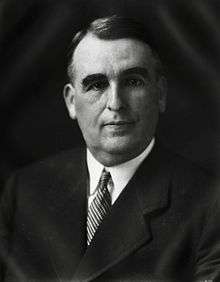Hugh L. White
| Hugh Lawson White | |
|---|---|
 | |
| 45th Governor of Mississippi | |
|
In office January 26, 1936 – January 16, 1940 | |
| Lieutenant | Jacob Buehler Snider |
| Preceded by | Martin Sennett Conner |
| Succeeded by | Paul B. Johnson Sr. |
| 51st Governor of Mississippi | |
|
In office January 22, 1952 – January 17, 1956 | |
| Lieutenant | Carroll Gartin |
| Preceded by | Fielding L. Wright |
| Succeeded by | James P. Coleman |
| Personal details | |
| Born |
August 19, 1881 near McComb, Mississippi |
| Died |
September 20, 1965 (aged 84) McComb, Mississippi |
| Political party | Democratic |
| Spouse(s) | Judith Wier Sugg |
| Profession | Businessman |
| Religion | Presbyterian |
Hugh Lawson White (August 19, 1881 – September 20, 1965) was an American politician from Mississippi and a member of the Democratic Party. He served two non-consecutive terms as Governor of Mississippi (1936–1940, 1952–1956).
Biography
White was born near McComb and attended the University of Mississippi where he was a member of St. Anthony Hall.
White was a wealthy industrialist and had been mayor of Columbia when he was first elected to the governorship. In 1936 he established the Balance Agriculture With Industry (BAWI) program that sought to develop an industrial base that matched the state's agricultural base. Under BAWI, advertising and incentives were deployed in hopes of enticing industries to locate to the state. Local governments could issue bonds to construct factories that could be leased to companies (who were also offered tax breaks).
After leaving office due to term limits, White was a delegate representing Mississippi at the 1948 Democratic National Convention.
.jpg)
In 1951, White won a second term, during which the issue of school segregation was a main issue. During the 1940s and early 1950s, federal courts made a series of decisions that indicated that the notion of "separate but equal" schools would soon be declared unconstitutional. Governor White and the state legislature prepared for that possibility by creating plans that sought to improve black schools. Among the proposals were increasing black teacher salaries to match white teachers' and building black schools on par with white schools. White called one hundred of the state's black leaders to a meeting at the capital to ask for their support of the plan. Much to his surprise, they overwhelmingly rejected his "voluntary" segregation plan and instead stated that they wanted only an integrated school system. In 1954, the U.S. Supreme Court made the famous Brown v. Board of Education decision that declared the practice of "separate but equal" to be unconstitutional.
On August 28, 1955, towards the end of White's term as governor, the infamous murder of Emmett Till took place. Three months earlier, an African American minister, George W. Lee, had been shot and killed by a group of white racists who drove by in an automobile. The vice president of the Regional Council of Negro Leadership and an NAACP worker, Lee had been urging African-Americans in the Mississippi Delta to register and vote. The killer was never identified, partly because White refused to order an official investigation.
Tributes
Hugh White State Park, a Mississippi state park, is named for him.
External links
- Hugh L. White at Find a Grave
- Mississippi Governor Hugh Lawson White from the National Governors Association website at the Wayback Machine (archived June 29, 2011)
| Political offices | ||
|---|---|---|
| Preceded by Martin Sennett Conner |
Governor of Mississippi 1936–1940 |
Succeeded by Paul B. Johnson Sr. |
| Preceded by Fielding L. Wright |
Governor of Mississippi 1952–1956 |
Succeeded by James P. Coleman |
.svg.png)
